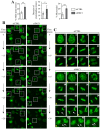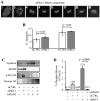Dyskerin localizes to the mitotic apparatus and is required for orderly mitosis in human cells
- PMID: 24303026
- PMCID: PMC3841160
- DOI: 10.1371/journal.pone.0080805
Dyskerin localizes to the mitotic apparatus and is required for orderly mitosis in human cells
Abstract
Dyskerin is a highly conserved, nucleolar RNA-binding protein with established roles in small nuclear ribonucleoprotein biogenesis, telomerase and telomere maintenance and precursor rRNA processing. Telomerase is functional during S phase and the bulk of rRNA maturation occurs during G1 and S phases; both processes are inactivated during mitosis. Yet, we show that during the course of cell cycle progression, human dyskerin expression peaks during G2/M in parallel with the upregulation of pro-mitotic factors. Dyskerin redistributed from the nucleolus in interphase cells to the perichromosomal region during prometaphase, metaphase and anaphase. With continued anaphase progression, dyskerin also localized to the cytoplasm within the mid-pole region. Loss of dyskerin function via siRNA-mediated depletion promoted G2/M accumulation and this was accompanied by an increased mitotic index and activation of the spindle assembly checkpoint. Live cell imaging further revealed an array of mitotic defects including delayed prometaphase progression, a significantly increased incidence of multi-polar spindles, and anaphase bridges culminating in micronucleus formation. Together, these findings suggest that dyskerin is a highly dynamic protein throughout the cell cycle and increases the repertoire of fundamental cellular processes that are disrupted by absence of its normal function.
Conflict of interest statement
Figures





References
-
- Ruggero D, Grisendi S, Piazza F, Rego E, Mari F, et al. (2003) Dyskeratosis congenita and cancer in mice deficient in ribosomal RNA modification. Science 299: 259–262. - PubMed
-
- Mitchell JR, Wood E, Collins K (1999) A telomerase component is defective in the human disease dyskeratosis congenita. Nature 402: 551–555. - PubMed
Publication types
MeSH terms
Substances
Grants and funding
LinkOut - more resources
Full Text Sources
Other Literature Sources

